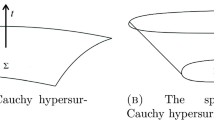Abstract
A version of the vacuum conservation theorem is proved which does not assume the existence of a time function nor demands stronger properties than the dominant energy condition. However, it is shown that a stronger stable version plays a role in the study of compact Cauchy horizons.
Similar content being viewed by others
Notes
That the former characterization implies the latter is clear. For the converse, if at the given point \(T= 0\) or if no causal vector is sent to zero we have finished. Thus assume \(T\ne 0\) and there is a f.d. causal vector \(w\) which has zero image. Since \(T\ne 0\) there is a f.d. causal vector \(v\) such that \(u^b:=-T^b_{\ a} v^a\ne 0\), necessarily f.d. timelike by assumption, then \(0=T(w,v)=-g(w,u)\) which is a contradiction since it must be positive.
Hawking [6, p. 293] claims a similar result but his proof and claim seem incorrect. He assumes a weaker form of energy condition, which does not exclude the possibility \(T^{ab}=\alpha n^a n^b\), where \(n\) is a lightlike vector, and then he applies a version of the conservation theorem which he has not really proved. Probably he used Eq. (8) missing the difference between \(\hat{S}\) and \(S\), and that between \(V\) and \(n\).
References
Carter, B.: Energy dominance and the Hawking-Ellis vacuum conservation theorem. In: The Future of the Theoretical Physics and Cosmology (Cambridge, 2002), pp. 177–184. Cambridge Univ. Press, Cambridge (2003)
Evans, L.C., Gariepy, R.F.: Measure Theory and Fine Properties of Functions. CRC Press, Boca Raton (1992)
Hall, G.S.: Energy conditions and stability in general relativity. Gen. Relativ. Gravit. 14, 1035–1041 (1982)
Hartman, P.: Ordinary differential equations. Wiley, New York (1964)
Hawking, S.: The conservation of matter in general relativity. Comm. Math. Phys. 18, 301–306 (1970)
Hawking, S.W., Ellis, G.F.R.: The Large Scale Structure of Space–Time. Cambridge University Press, Cambridge (1973)
Lang, S.: Differential and Riemannian Manifolds. Springer, New York (1995)
Lee, J.M.: Introduction to Smooth Manifolds. Springer, New York (2003)
Minguzzi, E.: Causality and entropic arguments pointing to a null Big Bang hypersurface. J. Phys.: Conf. Ser. 314, 012098 (2011). Contribution to the proceedings of the conference ’XXXIII Spanish Relativity Meeting, Gravity as a crossroad in physics’, Granada (Spain), September 6–10, 2010
Minguzzi, E.: Area theorem and smoothness of compact Cauchy horizons (2014). arXiv:1406.5919
Minguzzi, E.: Augustine of Hippo’s philosophy of time meets general relativity. Kronoscope 14, 71–89 (2014). arXiv:0909.3876
Pfeffer, W.F.: The Divergence Theorem and Sets of Finite Perimeter. CRC Press, Boca Raton (2012)
Author information
Authors and Affiliations
Corresponding author
Additional information
Work partially supported by GNFM of INDAM.
Rights and permissions
About this article
Cite this article
Minguzzi, E. The vacuum conservation theorem. Gen Relativ Gravit 47, 32 (2015). https://doi.org/10.1007/s10714-015-1878-4
Received:
Accepted:
Published:
DOI: https://doi.org/10.1007/s10714-015-1878-4




